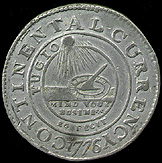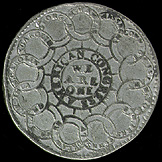The Continental Currency "Dollar" of 1776
obverse |
|
reverse |
| |||
1776 Newman 3-D Continental Congress Dollar
Obverse: [outer ring] CONTINENTAL CURRENCY 1776 [Inner ring]
FUGIO EG FECIT [below sundial] MIND YOUR / BUSINESS [Sundial
numerals: I, II, III, (four behind gnomon) V, VI, (space) VII, XII, X, IX,
IIX] .
Reverse: [within ring] AMERICAN CONGRESS [in center] WE / ARE
/ ONE [within rings:] N. HAMPIS / MASSACHS / CONNECT / R. ISLAND
/ N. YORKE / N. JERS[EY] / PENNSILV / DELAWARE / MARYLAND / VIRGINIA / N.
CAROLIN / S. CAROLIN / G[E]ORGIA [Brackets denote weak letters.]
Weight: 276.5 g (17.92 grams) Diameter: 40.6 mm
Comments: This coin belongs to Hodder's group two category. Group two used different die sinkers than group one and may even be from a different mint. The obverse can easily be distinguished as die 3 by the "EG FECIT". This is the only signature die in the series, all others are blank in that space.
The reverse, known as Newman D, is actually the second of only two reverse dies and can also be easily identified. It has a full size N in AMERICAN without a stop, while the other reverse die has a half size N with a stop below. It can also be identified by a die break that first appears as a line through the rings from Massachusetts through New Jersey and progressively lengthened to include the rings from Georgia through Delaware. Based on the growth of the die break Hodder suggests that this die combination was the first to be struck in group two, initally in pewter, then in both silver and pewter. The reverse was then combined with obverse die 4, then with obverse 3 again, then with obverse 5 and finally with obverse 3 once again (all in pewter). In this example the die break appears to extend from the bottom of the first G in Georgia, where it is very light; it becomes heavier at the final A and can be easily seen in the lower portion of the Massachusetts ring. It continues rather prominently to the final E in New Yorke and then stops inside the New Jersey ring. The following three rings contain grafitti as follows: scratch marks appear in the PA ring, while there is a B in each on the DE and MD rings. This example appears to be from an intermediate use of the die as the break has progressed more than its early state but is not as long as the late state.
Provenance: From the Robert H. Gore, Jr. Numismatic Collection.
| Virgina Halfpenny | Section Contents | State Patterns |
|
For viewing tips and information on optimal computer settings click
here.
For questions or comments contact Special Collections by: |

